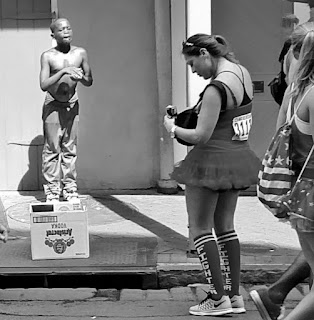I had intended to post a collection of colorful photos on Facebook from a recent visit to New Orleans, where I met up with my sister from California.
But the photos told a more important story in black and white. Let me explain:
It's now been
10 years since Hurricane Katrina, and I found a city full of warmth (literal and figurative), sound (noise and music) and smell (food and garbage) in its wake.
New Orleans was also bathed in red -- on the occasion of its annual Red Dress Run.
The Times-Picayune was an unapologetic cheerleader of this event, portraying it as a massive dress-up of harmless fun designed to raise $200,000 for local charities. Silly feature stories -- "Were you among those who dared to bare (your legs)?" and "On the hunt for the perfect red dress" -- were accompanied by photos of young men wearing red skirts, dresses and negligees.
Meanwhile, the comments sections to these same stories suggested a darker side -- just an excuse for people... primarily rich white people... to throw on something red and drink: "Mardi Gras minus the floats... a big frat party with a bunch of post-college desperados... another embarrassing display for people to be obnoxious and narcissistic..."
I don't know what the truth is -- but the only images I remember, like one below, are decidedly black and white.
Here's a boy, drenched in sweat, tap dancing on the sidewalk of Bourbon Street for spare change. It's high noon and literally 100 degrees in the hard-to-find shade. In the background, the boy's young mother is urging him and his younger brother to keep dancing.
A sea of people pass them by. Almost all the people on the street are white. Almost all the people on the periphery -- the street performers, the livery drivers, the waitresses -- are black.
I'm right in the middle of the street, and I blend in perfectly with all the faces. The only way I stand apart is that I'm not wearing red.
I'm in a vast crowd of sloppy drunks, in all stages of red undress. A frat boy impatiently pounds the hood of an ambulance trying to snake its way up the street. A bouncer sidles up and jovially offers me a "Big-Ass Beer" in a go-cup, inviting me inside, where there's air conditioning blasting from a huge open entranceway and where, he laughs, "There's no cover charge for white folks."
Further up the street, a chanting, raucous crowd circles a DJ blasting rhythmic music. In the center of the circle, a fat middle-aged white man bends over, supporting his hands on either side of a portable sound system, while another fat middle-aged white man simulates having sex with him from behind. Both are wearing red dresses.
Still further up the street, an American flag hangs next to a red dress mounted on an adjoining flagpole. On a second-floor balcony, so many college-aged drinkers are packed together that the wood flooring is noticeably buckling from their weigh. The coeds resemble the young women in the University of Alabama's
sorority recruitment video.
A nearby signpost tells me I've reached the corner of St. Ann Street. Its namesake, in my religious tradition, is the mother of Mary and the grandmother of Christ. She is also known as Mother of the Poor. And, yes, in iconography she wears a red dress.
The next morning, I took an air-conditioned minibus tour of the town. A downpour the previous evening had washed away the smell of the garbage on Bourbon Street. We visited the City of the Dead, where our jovial tour director, a longtime resident named Dino, told tales of people being buried alive.
Dino also drove us past small houses still devastated and gutted from 10 years ago in the Upper 9th Ward. He told us he couldn't drive us into the even-more-Katrina-damaged Lower 9th Ward because residents there had long ago grown weary of all the tour buses gawking at their neighborhood. They had started to charge tour operators admission fees.
It's all so complicated. The older I get, the more I see shades of gray. So instead of a Facebook post, let me offer this prayer:
Dearest St. Ann, Mother of the Poor, on this 10th anniversary of an American tragedy, help us change our world for the better. Show us the rich colors of people celebrating together, not separately. Extend the joy and generosity of spirit found in New Orleans to reach all in poverty, all still waiting for a home and all still searching for answers.














